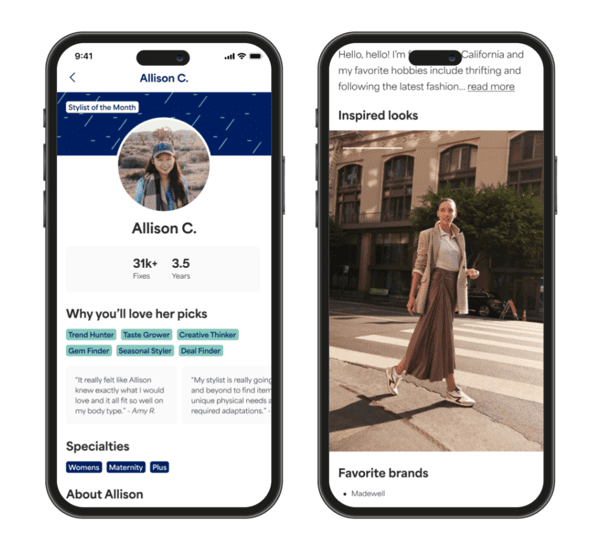These days it seems everyone is an “AI company” — whether the goal is boosting SEO or sales or just general prestige, any company that is able to has tacked “AI” somewhere onto their name or tagline. Stitch Fix, however, has resisted that urge, despite having been an AI-centered company from its inception 14 years ago. In fact, while others look for ways to work AI into every sentence, Stitch Fix has decided to shine the spotlight on something else — its human stylists.
“If you’ve never had someone dress you, you may not realize what an intimate thing it is,” said Sarah Funderburk, VP of Styling and Client Support at Stitch Fix in an interview with Retail TouchPoints. “I’ve been a client [of Stitch Fix] for longer than I’ve worked here, and in that time I’ve gotten married, I’ve switched jobs, I’ve had two babies — if I laid all those clothes out next to each other, it would tell a story of me and my relationship with Stitch Fix. That’s the thing that I’m most passionate about — it’s not about transactions; it’s about that long-term relationship. What is the story that the client’s closet is telling over time and what does it say about our relationship with them?”

Which isn’t to say that AI has nothing to do with it — quite the opposite, in fact: “AI has been at the center of our business from day one, but it’s always been about this balance of delivering best-in-class personalization and data science recommendations driven by AI, together with the creativity and human empathy of our stylists,” said Noah Zamansky, VP of Client Experience at Stitch Fix in an interview with Retail TouchPoints. “We’re always looking at how we can actually achieve this balance, and not overswing in any one direction. But the magic, we believe, happens when we’re able to marry that human creativity with the science.”
While Stitch Fix’s human-centered approach to AI hasn’t changed since it was founded in 2011, the world around the company has changed dramatically. In addition to rapid advances in AI that have brought the technology into the mainstream, Stitch Fix also has struggled to maintain its first-mover advantage in the world of subscription fashion, with a host of new entrants pulling away clients and market share.
Advertisement
In mid-2024, under the leadership of new CEO Matt Baer, Stitch Fix launched a sweeping transformation strategy aimed at regaining its former standing as consumers’ go-to for personalized fashion. While these efforts have yet to bear tangible fruit — active clients and revenues were still declining in the company’s 2025 Q2, which ended Feb. 1 — there are signs that a turnaround is in the making. Revenue per active client for the quarter was up 4% year-over-year to $537 on average, and both the men’s business and Freestyle channel have returned to top-line revenue growth. Not to mention that Stitch Fix finds itself in an enviable position at this critical cultural moment — with both excitement and fear about AI reigning in equal measure, Stitch Fix stands as a leading example of how to find the right balance between humans and machines.
Funderburk and Zamansky shared how the company is doubling down on its human-centered AI approach to create a more customer-centric shopping experience and return the company to growth.
Empowering Customers to ‘Shape the Algorithm’
The basic premise of Stitch Fix has remained the same since the beginning. Customers begin by taking a comprehensive quiz about their style preferences, fashion needs, size and fit requirements on either the Stitch Fix website or app. Clients are then matched with one of the 1,700 Stitch Fix stylists, who select items for that customer’s “Fix” from a list of available products that has been curated by Stitch Fix’s AI algorithm, based on the customer’s quiz responses. The customer’s Fix is shipped and they have three days to test out the items and select which ones they want to buy and which ones they’ll return.
“We have thousands of pieces of inventory and AI is empowering our stylists by automating that process, narrowing down [the options] by size, color preferences, etc.,” explained Funderburk. “If a client says, ‘I don’t like yellow,’ we should never show the stylist a yellow piece, unless yellow is suddenly trending and then we need to reevaluate. The recommendations algorithm really helps to narrow it down, allowing the stylist to focus on making the best outfits out of the most relevant pieces for that client.”
Part of the power of the Stitch Fix model is the transparency and depth of the information exchange with its clients. Unlike with more opaque applications of AI, customers are well aware that every action they take and piece of information they share is being used to inform the selection of products specifically for them.
“The client is telling us a lot about themselves, all in an effort to give us more relevant recommendations so that our stylist can get to know them better,” said Funderburk. “With each Fix, we’re able to perfect our understanding of the clients, so the more fixes a client gets, the better they become.”
Stitch Fix customers are incentivized to engage by the knowledge that the more they do, the better the results, and it’s the explicitness of this exchange that makes it so robust and successful. Among the inputs that fuel the Stitch Fix recommendations algorithm are everything from clients’ reactions to different styles presented to them in the onboarding quiz, the items they keep, the items they return and reasons for those returns, as well as a whole host of unstructured data in the form of customer notes and comments.
“The difference with us is that we really empower clients to shape the algorithm and the recommendations,” said Zamansky “They’re shaping the experience, and they know that it will get better the more input they provide.”
Stitch Fix Transformation: Making the Exchange More Two-Way
It’s a good model; in fact, when Stitch Fix first came on the scene in 2011 it felt revolutionary. Enthusiasm for this new way of shopping fueled the company in its early years, leading to its IPO in late 2017. But as with most good ideas, competitors followed, customers left, and with them went revenues.
In a bid to bring more variety to its offering, Stitch Fix introduced Freestyle in 2021, allowing users to shop individual items anytime from a selection that was curated using the same algorithm as that for Fixes. But share prices continued to slide and they remain low. The company went through two rounds of layoffs in 2022 and 2023, culminating in the hiring of Macy’s and Walmart veteran Matt Baer as CEO. Last year, Baer laid out his plan to turn it all around, beginning with a reimagining of the Stitch Fix brand and experience.

“Our experience was as an innovator, and we realized that clients had moved on,” said Zamansky. “The interaction was a little bit one-way, and we really wanted to evolve that experience to where our clients were heading.”
This encompassed a full rebrand, with “not a single page [of the website] left untouched,” according to Zamansky, as well as an expansion of the Fix format to include up to eight items instead of five and the introduction of StyleFile, a personalized style profile that every customer receives at the end of the onboarding quiz.
“Before, the style quiz was a one-way form, and now it’s a much more conversational, two-way experience that provides the client with micro feedback and personalization as they go through to indicate that we heard them,” explained Zamansky. “Then the payoff at the end is the StyleFile, which gives clients a new way to understand their style, be inspired and know that Stitch Fix gets them. It has had a huge impact in terms of the trust that it builds with our clients and our core conversion rates.”

The biggest move, though, has been a concerted effort to bring Stitch Fix stylists out from the background. “Our community of stylists, we believe, is what sets us apart,” said Funderburk. “Their expertise and their empathy are not something that can be replaced or replicated, so a big part of our effort to enhance the client experience and to continue to evolve with clients is putting a bigger spotlight on our stylists.”
Stylists now have social media-style profiles that clients can view with pictures, stats (how long they’ve been at Stitch Fix, how many Fixes they’ve styled, specialty areas like maternity or kids) and an About Me section where stylists can share a bit more about themselves and their point of view. Stylists can share client feedback on their profile, and that feedback also is used to generate badges that highlight certain skills, like “Taste Grower” (someone who is good at helping people get out of their fashion comfort zone) or “Trend Hunter” (a stylist who’s good at nailing down what’s hot at the moment).
“The response has been really positive,” said Funderburk. “Our clients are saying that they want the same stylist back more frequently, and we’re seeing those relationships really deepen now that they’re able to learn more about their stylists — while their stylist knows so much about them.”
Where AI Advancements will Take Stitch Fix Next
Even an AI leader like Stitch Fix is benefiting from the rapid advancements currently happening in AI. “AI’s been around for a long time, about 40 years, and we’ve been at it for 14 of those years so it’s really baked into the model,” said Zamansky. “The thing that’s most exciting over the last 12, and even more so, over the last six months, is just the pace at which the tools are developing and the extent to which AI is being embedded in every aspect of our business.”
While the recommendation and stylist tools always have been powered by AI, now Zamansky and the broader Stitch Fix tech team, led by Tony Bacos, are beginning to deploy AI solutions across other areas of the business, such as inventory planning, assortment development, creative development on the marketing side and additional tools for stylists, like an Outfits model that recommends different product pairings.
“Six months ago we were just experimenting in all these things; now every part of our business is actively embracing AI,” said Zamansky.
Looking ahead, Zamansky said one of the areas he’s most excited about “is how we can strengthen the client and stylist relationship through generative AI. Imagine sharing more inspirational AI-generated photos, or things like virtual try-on. This space is emerging really quickly and we think it could be a really powerful application of AI to strengthen the stylist-client relationship in terms of the visualization of style.”
If you’re attending Shoptalk next week, be sure to check out the session with Stitch Fix CEO Matt Baer, who will discuss the company’s transformation and personalization philosophy even further.















